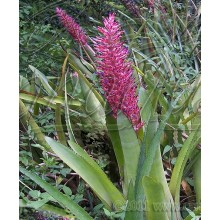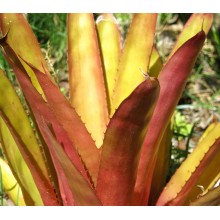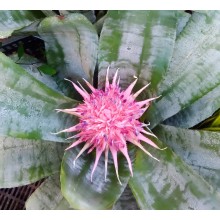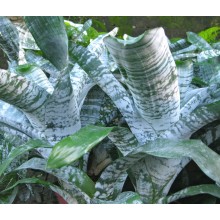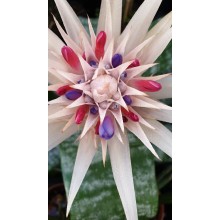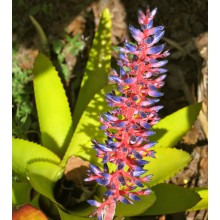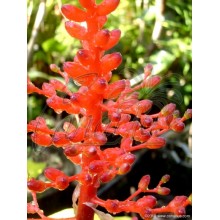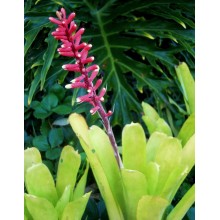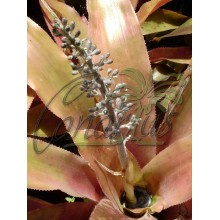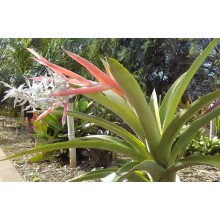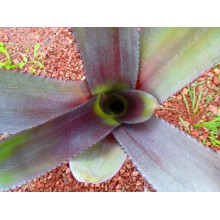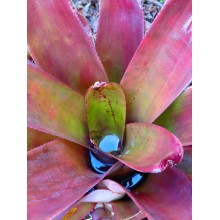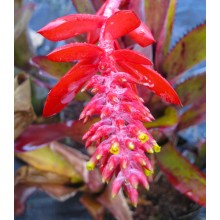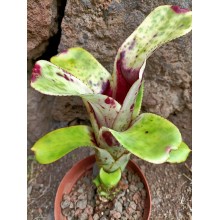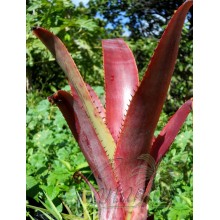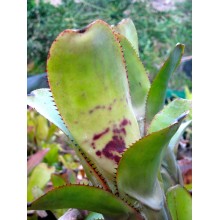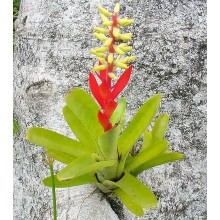Tutte le piante Ci sono 1882 prodotti.

Se vi piacciono le piante esotiche, allora sei nel posto giusto. Canarius offre le piante esotiche difficile da trovare che sono raramente disponibili in centri di giardinaggio. Il nostro negozio ha specie naturali e rari ibridi. Offriamo piante esotiche provenienti dalle Isole Canarie.
Gli ordini sono inviati a ovunque in Europa e anche in tutto il mondo. I pacchi raggiungeranno la vostra casa in pochi giorni dopo la spedizione (ma abbiamo bisogno anche alcuni giorni per l'elaborazione). Non esitate a contattarci se avete domande.
Sotto-categorie
-
Succulente
I deserti del mondo e le zone secche ospitano le piante più interessanti. Canarius offre una selezione crescente di piante succulente di massima qualità, perché sono coltivate all'aperto, in pieno sole delle Isole Canarie.
I succulente o "piante grasse" sono specie di ritenzione di acqua, adattate alle condizioni di asciutto. Loro accumulano succum (succo, acqua) nelle loro foglie, steli o radici, e spesso mostrano un aspetto robusto e carnoso.
-
Esotiche
Le piante esotiche sono specie provenienti da altre parti del mondo, e di solito hanno le qualità ornamentali: una vegetazione lussureggiante, fiori colorati, forme insolite... Qui è possibile trovare una grande varietà di piante esotiche: da bromeliacee e Heliconias, fino a palme e piante d'appartamento.
Le piante esotiche non hanno un uso particolare. I collettori acquistano questo tipo di piante per la loro rarità, per la decorazione interna o esterna, a seconda delle loro caratteristiche.
-
Da frutto & Per la salute
Le piante da frutto, erbe e piante medicinale sono concentrati su come ottenere una salute migliore. In questo contenuto della sezione, ogni tipo di pianta produce effetti salutari, entrambi alberi da frutto (Feijoa, Ananas, Fina Jete...) e piante per la salute, come Graviola, Aloe vera, Callisia fragrans... Nel normale metabolismo di tutti gli esseri viventi, l'organismo produce delle sostanze nutritive da latenti per l'ambiente; alcune di queste sostanze chimiche sono parte del processo in tutte le specie. Normalmente, i composti utili sono concentrati in alcune dei sue parti: foglie, semi, fiori...
-
Speciale
Su canarius.com cerchiamo di rimuovere i limiti nel campo della botanica. Sul nostro negozio online cerchiamo di facilitare l'acquisto / vendita di piante di tutto il mondo. Per questo motivo, coltiviamo piante di tutto il mondo, specie più comuni ed anche piante più particolari, come si può vedere in questa sezione.
-
Aechmea distichantha var. schlumbergeri
Aechmea distichantha var. schlumbergeri
Cold-hardy Aechmea found in Bolivia to NE. Argentina. It is a large, spiny plant 50-80 cm tall, producing long-lasting colourful inflorescences in Spring. Great in gardens or in tall pots. Hardy to about -6 C.
22,60 € -
Aechmea distichantha x fulgens discolor
Aechmea distichantha x fulgens discolor
New cold-hardy hybrid with spectacular colours. Leaves are golden to bronze, orange and dark green, the inflorescence is long-lasting.
37,70 € -
Aechmea fasciata
Aechmea fasciata
This particular clone of Aechmea fasciata is a wild-type form with the tipical tiny teeth on the leaf margins. Aechmea fasciata is one of the most popular of all bromeliads. It tolerates a wide range of conditions, including some cold weather. Its large pink inflorescences are a true beauty - only comparable to those of the most tropical, tender types.
12,50 € -
Aechmea fasciata 'Spineless'
Aechmea fasciata 'Spineless'
This is a non-hybrid, almost-spineless selection of this well known beautiful bromeliad. Aechmea fasciata is native to the cool forests in Rio de Janeiro, where it grows between 500 and 1200 m of altitude. It can be grown in pots or mounted.
17,50 € -
Aechmea fasciata 'White Spineless'
Aechmea fasciata 'White Spineless'
This is a non-hybrid, almost-spineless selection of this well known beautiful bromeliad. Aechmea fasciata is native to the cool forests in Rio de Janeiro, where it grows between 500 and 1200 m of altitude. It can be grown in pots or mounted.
19,20 € -
Aechmea fendleri
Aechmea fendleri
An old classic in fine tropical gardening. This mid to large bromeliad has stiff glossy leaves and a very long lasting, bright inflorescence, shimmering in blue and red.
29,30 € -
Aechmea fulgens var. fulgens
Aechmea fulgens var. fulgens
This bromeliad shows the reddest red you can imagine. Flowers and fruits shine during months above the apple green wide foliage.
14,50 € -
Aechmea gamosepala
Aechmea gamosepala
Fast growing mat-forming bromeliad. Small rosettes of pale green leaves produce bright spikes of pink and purple flowers, in the colder winter months. It can take low temperatures with little or no damage at -7 C (20 F) for several hours.
13,20 € -
Aechmea gamosepala var. nivea
Aechmea gamosepala var. nivea
NEW ! - Supreme flowering bromeliad. This variety was described in 1962 from Santa Catarina, in SE Brazil. It is much taller and stouter than the typical A. gamosepala and bears pink-and-white spikes in Spring. Tolerant of moderate cold.
14,00 € -
Aechmea leptantha 'Albo-marginata'
Aechmea leptantha 'Albo-marginata'
Large variegated bromeliad with bold rainbow colours, showing an impressive array of orange, pink, green, yellow and red.
56,00 € -
Aechmea lueddemanniana rubra
Aechmea lueddemanniana rubra
Elegant bromeliad with colourful mottled leaves. It bears a 40-60 cm long spike, with blue flowers. The show lasts for months as it becomes an attractive infructescence with white berries turning purple. Frost sensitive.
24,50 € -
Aechmea maculata
Aechmea maculata
Mid sized bromeliad, with a compact green rosette with thick curly leaves. It blooms in late winter to spring with an amazing inflorescence with pink bracts and yellow flowers.
26,00 € -
Aechmea mcvaughii- Ursulaea mcvaughii
Aechmea mcvaughii- Ursulaea mcvaughii
Ursulaea is a new genus, still uncommon in cultivation. It grows as an Aechmea with a beautiful pink-white fuzzy inflorescence and blue flowers. Leaves are silvery underneath, green if hot and shady and golden-copper in cool sunny weather.
56,80 € -
Aechmea mulfordii 'Malva'
Aechmea mulfordii 'Malva'
This is one of finest clones of the large sized, showy Aechmea mulfordii. 'Malva' has wide and thick silvery-mauve leaves that come in a colour different from most other bromeliads. ... and with the tall yellow inflorescence is an absolute winner!
37,00 € -
Aechmea mulfordii 'Rubra'
Aechmea mulfordii 'Rubra'
This is the true 'Rubra' clone of Aechmea mulfordii, with deep pink to orange tones in the leaves. It becomes a spectacular plant, excellent for landscaping or in outstanding pots.
37,00 € -
Aechmea nudicaulis 'Blumenau'
Aechmea nudicaulis 'Blumenau'
First time offering of a new clone of Aechmea nudicaulis collected on the hills above Blumenau in Southern Brazil. Small sized, compact, with colourful speckled leaves with rounded tips.
28,00 € -
Aechmea nudicaulis 'Viñales'
Aechmea nudicaulis 'Viñales'
Upright Northern form of Aechmea nudicaulis, with tapering leaftips, often curly. Leaves turn purple-reddish in the cooler or drier months. It is robust and grows a bit larger than other nudicaulis.
18,30 € -
Aechmea nudicaulis green
Aechmea nudicaulis green
NEW;Aechmea nudicaulis is a Bromeliad species in the genus Aechmea, which is often used as an ornamental plant. This species is native to Central America, the West Indies, central and southern Mexico, and northern and central South America.
16,70 €
Al momento ci sono pochi prodotti in questa categoria Tutte le piante




















